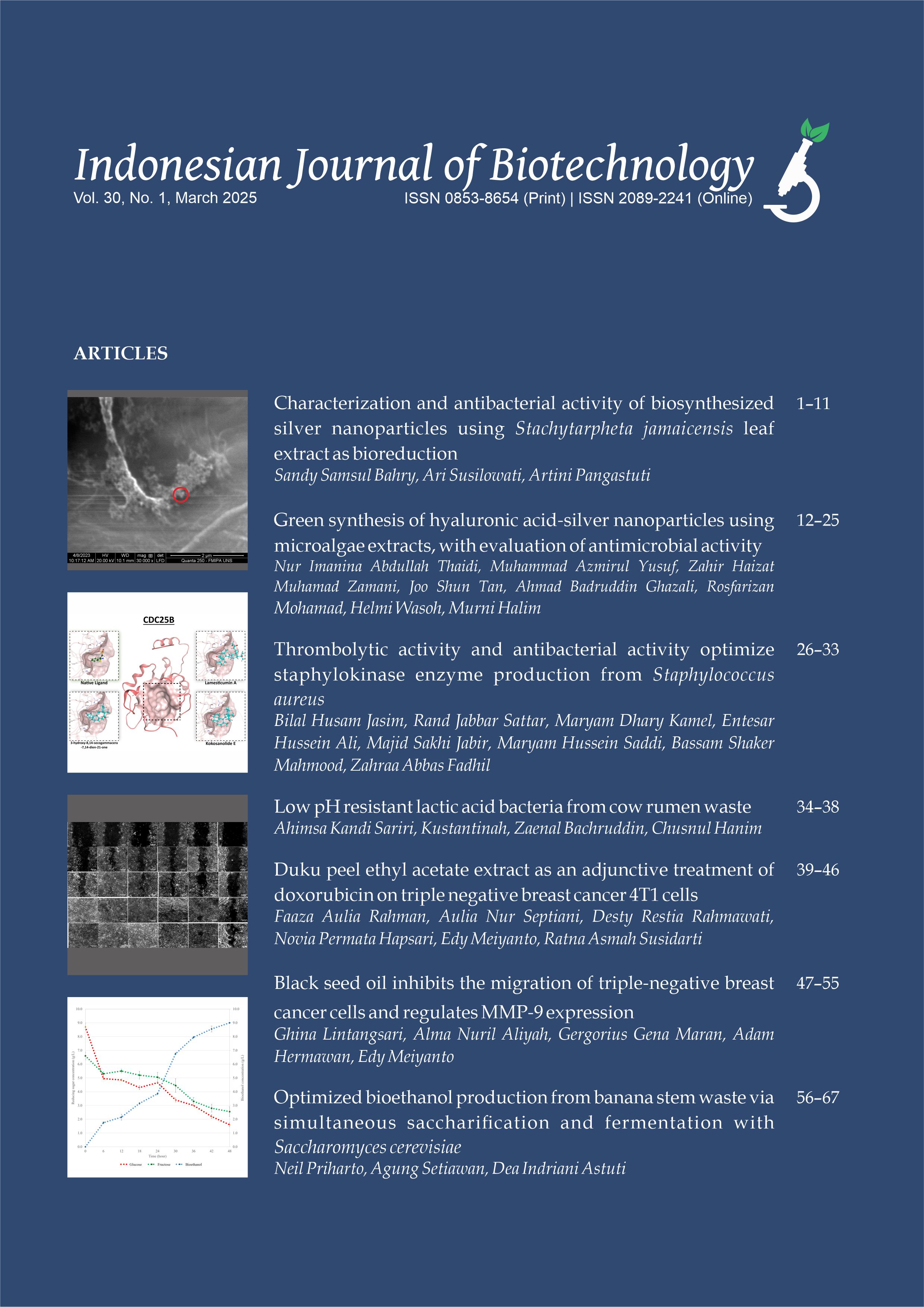Antibacterial activity of mycelial extract from a local fungus, Sclerotium rolfsii
Muhandinni Zahra(1*), I Nyoman Pugeg Aryantha(2), Sukrasno Sukrasno(3), Veronica Sri Harjati Suhardi(4)
(1) School of Life Sciences and Technology, Institut Teknologi Bandung, Jl. Ganesha No.10, Bandung, 40132, Indonesia
(2) School of Life Sciences and Technology, Institut Teknologi Bandung, Jl. Ganesha No.10, Bandung, 40132, Indonesia; Institut Teknologi Sumatra, Jl. Terusan Ryacudu, South Lampung, 35365, Indonesia
(3) School of Pharmacy, Institut Teknologi Bandung, Jl. Ganesha No.10, Bandung, 40132, Indonesia
(4) School of Life Sciences and Technology, Institut Teknologi Bandung, Jl. Ganesha No.10, Bandung, 40132, Indonesia
(*) Corresponding Author
Abstract
Keywords
References
Abubakar AR, Haque M. 2020. Preparation of medicinal plants: Basic extraction and fractionation procedures for experimental purposes. J. Pharm. Bioallied Sci. 12(1):1–10. doi:10.4103/jpbs.JPBS_175_19.
Adeniran OI, Musyoki AM, Sethoga LS, Mogale MA, Gololo SS, Shai LJ. 2022. Phytochemical profile, antiglycation effect, and advanced glycation endproducts protein crosslink breaking ability of Sclerocarya birrea stembark crude extracts. J. Herbmed Pharmacol. 11(4):529–539. doi:10.34172/jhp.2022.61.
Ajiboye TO, Visser HG, Erasmus E, SchutteSmith M. 2025. Recent strategies for controlling the white mould fungal pathogen (Sclerotinia sclerotiorum) using gene silencing, botanical fungicides and nanomaterials. Sustain. Food Technol. 3:612–636. doi:10.1039/d4fb00348a.
Andrade JC, MoraisBraga MFB, Guedes GMM, Tintino SR, Freitas MA, Menezes IRA, et al. 2014. Enhancement of the antibiotic activity of aminoglycosides by alphatocopherol and other cholesterol derivates. Biomed. Pharmacother. 68(8):1065–1069. doi:10.1016/j.biopha.2014.10.011.
Balouiri M, Sadiki M, Ibnsouda SK. 2016. Methods for in vitro evaluating antimicrobial activity: A review. J. Pharm. Anal. 6(2):71–79. doi:10.1016/j.jpha.2015.11.005.
Calvo AM, Cary JW. 2015. Association of fungal secondary metabolism and sclerotial biology. Front. Microbiol. 6:62. doi:10.3389/fmicb.2015.00062.
Coltescu AR, Butnariu M, Sarac I. 2020. The importance of solubility for new drug molecules. Biomed. Pharmacal. J. 13(2):577–583. doi:10.13005/BPJ/1920.
Dzobo K. 2022. The role of natural products as sources of therapeutic agents for innovative drug discovery. Compr. Pharmacol. 2:408–422. doi:10.1016/B9780 128204726.000414.
García-Salinas S, Elizondo-Castillo H, Arruebo M, Mendoza G, Irusta S. 2018. Evaluation of the antimicrobial activity and cytotoxicity of different components of natural origin present in essential oils. Molecules 23(6). doi:10.3390/molecules23061399.
Gonzalez JM, Aranda B. 2023. Microbial growth under limiting conditionsfuture perspectives. Microorganisms 11(7). doi:10.3390/microorganisms11071641.
Graf TN, Kao D, RiveraChávez J, Gallagher JM, Raja HA, Oberlies NH. 2020. Drug leads from endophytic fungi: Lessons learned via scaled production. Planta Med. doi:10.1055/a11304856.
Idris FN, Nadzir MM. 2021. Comparative studies on different extraction methods of Centella asiatica and extracts bioactive compounds effects on antimicrobial activities. Antibiotics 10(4). doi:10.3390/antibiotics10040457.
Künzler M. 2018. How fungi defend themselves against microbial competitors and animal predators. PLoS Pathog. 14(9). doi:10.1371/journal.ppat.1007184.
Lau BF, Abdullah N. 2015. Sclerotiumforming mushrooms as an emerging source of medicinals: Current perspectives. Mushroom Biotechnol. San Diego (CA): Academic Press. p. 111–136. doi:10.1016/B9780128027943.000072.
Li Y, Song YC, Liu JY, Ma YM, Tan RX. 2005. AntiHelicobacter pylori substances from endophytic fungal cultures. World J. Microbiol. Biotechnol. 21(4):553–558. doi:10.1007/s1127400432732.
Lini IF, Zinnurine R, Rahman MH, Begum MN, Afroz F, Rony SR, et al. 2020. Bioactivity screening and identification of secondary metabolites from fungal endophytes of Carica papaya L. leaves. J. Nat. Remedies 20(4):217–227. doi:10.18311/jnr/2020/24110.
Lv J, Liu S, Zhang X, Zhao L, Zhang T, Zhang Z, et al. 2023. VdERG2 was involved in ergosterol biosynthesis, nutritional differentiation and virulence of Verticillium dahlia. Curr. Genet. 69:25–40. doi:10.1007/s00294022012579.
Mawardi RH, Sulistyani N, Nurkhasanah N, Desyratnaputri R. 2020. Antibacterial activity and TLCbioautography analysis of the active fractions of Muntingia calabura L. leaves against Staphylococcus aureus. J. Pharm. Sci. Community 17(2):69–75. doi:10.24071/jpsc.002362.
Nurhalimah, Muhibuddin A, Syib’li MA. 2022. Screening of yeast isolates for the biocontrol of Sclerotium rolfsii. Biodiversitas 23(7):3820–3826. doi:10.13057/biodiv/d230759.
Nyochembeng L, Holloway I, Hopkinson S. 2017. Antimicrobial activity of extracts from in vitro mycelia culturederived sclerotia of Sclerotium rolfsii. Int. J. Bioresour. Stress Manag. 8(1):183–186.
OrdóñezValencia C, FerreraCerrato R, QuintanarZúñiga R, FloresOrtiz C, Márquez Guzmán G, Alarcón A, Larsen J, GarcíaBarradas O. 2015. Morphological development of sclerotia by Sclerotinia sclerotiorum: A view from light and scanning electron microscopy. Ann. Microbiol. 65(2):765–770. doi:10.1007/s132130140916x.
Petersen L, Frisvad J, Knudsen P, Rohlfs M, Gotfredsen C, Larsen T. 2015. Induced sclerotium formation exposes new bioactive metabolites from Aspergillus sclerotiicarbonarius. J. Antibiot. 68(10):603–608. doi:10.1038/ja.2015.40.
Rangsinth P, Sharika R, Pattarachotanant N, Duangjan C, Wongwan C, Sillapachaiyaporn C, et al. 2023. Potential beneficial effects and pharmacological properties of ergosterol, a common bioactive compound in edible mushrooms. Foods 12(13). doi:10.3390/foods12132529.
Ranjan A, Westrick N, Jain S, Piotrowski J, Ranjan M, Kessens R, Stiegmen L, et al. 2019. Resistance against Sclerotinia sclerotiorum in soybean involves a reprogramming of the phenylpropanoid pathway and upregulation of antifungal activity targeting ergosterol biosynthesis. Plant Biotechnol. J. 17(8):1567– 1581. doi:10.1111/pbi.13082.
Shashini Janesha U, Rathnayake H, Hewawasam R, Dilip Gaya Bandara Wijayaratne W. 2020. In vitro evaluation of the antimicrobial activity of leaf extracts of Litsea iteodaphne against a selected group of bacteria including methicillinresistant Staphylococcus aureus. Adv. Biomed. Res. 9(1):21. doi:10.4103/abr.abr_234_19.
Sikkema J, de Bont J, Poolman B. 1994. Interactions of cyclic hydrocarbons with biological membranes. J. Biol. Chem. 269(11):8022–8028.
Stanley H, Onwuna D, Ugboma C. 2018. The antimicrobial activity of sclerotia of Pleurotus tuberregium (Osu) on some clinical isolates. J. Adv. Microbiol. 8(4):1–4. doi:10.9734/jamb/2018/39664.
SułkowskaZiaja K, Trepa M, OlechowskaJarząb A, Nowak P, Ziaja M, Kała K, Muszyńska B. 2023. Natural compounds of fungal origin with antimicrobial activity—potential cosmetics applications. Pharmaceuticals 16(9):1200. doi:10.3390/ph16091200.
Taguri T, Tanaka T, Kouno I. 2006. Antibacterial spectrum of plant polyphenols and extracts depending upon hydroxyphenyl structure. Biol. Pharm. Bull. 29(11):2226–2235. doi:10.1248/bpb.29.2226.
Teh C, Nazni W, Hamid A, Norazah A, Lee H. 2017. Determination of antibacterial activity and minimum inhibitory concentration of larval extract of fly via resazurinbased turbidometric assay. BMC Microbiol. 17(1). doi:10.1186/s1286601709363.
Tharavecharak S, D’AlessandroGabazza C, Toda M, Yasuma T, Tsuyama T, Kamei I, Gabazza E. 2023. Culture conditions for mycelial growth and anticancer properties of termitomyces. Mycobiology 51(2):94– 108. doi:10.1080/12298093.2023.2187614.
Wang M, Zhang Y, Wang R, Wang Z, Yang B, Kuang H. 2021. An evolving technology that integrates classical methods with continuous technological developments: Thinlayer chromatography bioautography. Molecules 26(15). doi:10.3390/molecules26154647.
Xing Y, et al. 2022. Armillaria mellea symbiosis drives metabolomic and transcriptomic changes in Polyporus umbellatus sclerotia. Front. Microbiol. 12:792530. doi:10.3389/fmicb.2021.792530.
Yaderets V, Karpova N, Glagoleva E, Ovchinnikov A, Petrova K, Dzhavakhiya V. 2021. Inhibition of the growth and development of Sclerotinia sclerotiorum (Lib.) De Bary by combining azoxystrobin, Penicillium chrysogenum VKM F 4876d, and Bacillus strains. Agronomy 11(12):2520. doi:10.3390/agronomy11122520.
Yokokawa D, Tatematsu S, Imai M, Takara Y, Saga Y, Fischer F, Becker H, Nakajima H, Kushiro T. 2025. Sterol aminoacylation regulates conidiation and sclerotia formation in Aspergillus oryzae. Fungal Biol. 129(5):101169. doi:10.1016/j.funbio.2025.101609.
Article Metrics
Refbacks
- There are currently no refbacks.
Copyright (c) 2025 The Author(s)

This work is licensed under a Creative Commons Attribution-ShareAlike 4.0 International License.









